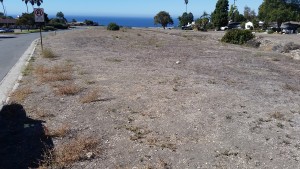An Introduction to Beautify Lunada Bay
Tired of the neglected bluff top and parkland areas in Lunada Bay plagued by dust or mud, and weeds? The LBHOA has been sponsoring an initiative called Beautify Lunada Bay (BLB). Our goal is to restore the neglected open space with native, drought tolerant, low maintenance plants and pathways.
Why Beautify Lunada Bay?
With beautiful homes and spectacular ocean and canyon views what is left to “beautify”?
- A close look will reveal there are areas that truly need our help.
- Visit our open spaces and look where you are standing. What do you see?
– Walking paths that are dusty or muddy depending on the season.
– Invasive weeds that often grow to for or more feet tall and require frequent mowing.
– Few birds or butterflies.
– In short, a neglected ecosystem with barren dirt, mown weeds or a generous dumping of wood chips.
We can do better, much better. And while the City may not have the resources to address this problem, residents can work together to solve the problem.

The Lunada Bay Homeowners Association has initiated the Beautify Lunada Bay (BLB) project as a joint effort with the City of Palos Verdes Estates and the Palos Verdes Peninsula Land Conservancy. Its goals are to improve open space areas by:
- Clearing weeds and debris.
- Planting low water, low maintenance indigenous plants.
- Installing walking stable and safe pathways.
- Providing places to pause and enjoy the view.
The Plan & Phase 1 Pilot Project
The LBHOA plan includes the overall vision and describes a Phase 1 Pilot Project that restores about one acre of Lunada Canyon open space across the street from Lunada Bay Elementary School. This site was chosen due to its visibility, extensive use, and educational benefits.
The pilot project accomplished the following:
- Incorporates and demonstrates the type of plants that could be used in other bluff-top areas — even in private residence landscape projects.
- Includes a short segment of a walking path with seating areas. The pilot would provide experience and understanding for the extended open space restoration.
Donations from residents and grants were used for preparing the ground, installing plants and a drip-water system, establishing a trail segment, and the three years of maintenance required to re-establish the health ecosystem. Key features are:
This Pilot Project has demonstrated to State and Federal agencies and other long-term grant sources that our community has a viable plan and is committed to maintaining and preserving our open space heritage, to water conservation, and to habitat restoration via responsible stewardship.